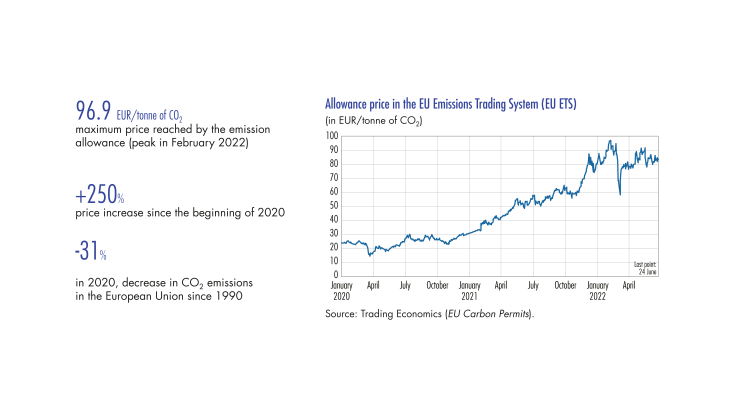The urgent need for action on climate change, confirmed by the latest report of the Intergovernmental Panel on Climate Change (IPCC), has been internationally acknowledged since the Kyoto Protocol (December 1997). Following the Paris Agreement (December 2015), the first legally binding climate agreement, the international community agreed to limit the global temperature increase to well below 2°C compared to pre-industrial levels. In December 2019, the European Union (EU) published the Green Deal, which, through the European Climate Law of 30 June 2021, aims to make Europe climate neutral by 2050 by reducing greenhouse gas (GHG) emissions, the main one being CO2.
Global CO2 emissions reached an all-time high of 36.3 billion tonnes in 2021. China, India and emerging economies are among the fastest growing contributors (see Chart 1), with the EU accounting for only about 10% of direct emissions, decreasing slightly. However, the EU needs to pursue its transition in certain high-emitting sectors (transport – EEA, 2021) and to play a leading role in encouraging the major economies to take climate issues into account.
In order to achieve this, Europe already has an instrument at its disposal: the EU Emissions Trading System (EU ETS). However, two problems remain:
• The first concerns the scope of application and the price of the carbon allowance: the decarbonisation of economies requires that this price be both high and predictable to enable companies to build their investment strategies. To achieve this, the EU ETS must be extended and revised.
• Furthermore, while the production of GHGs in Europe has decreased, the carbon footprint (i.e. the GHGs contained in the products consumed) remains almost unchanged due to the increase in emissions associated with imports. To address this issue, the EU decided to introduce a Carbon Border Adjustment Mechanism (CBAM), the aim of which is to reduce the bypassing of reductions or carbon leakage.
1. Why and how should a carbon price be set?
The economic foundations
In order to steer investment and consumption behavior towards activities that emit less GHGs, an economically efficient instrument is to provide a carbon price signal that increases over time. This price makes it possible to calibrate the cost of GHG emissions to society as a whole and to encourage governments to reduce their consumption, particularly of oil and coal. Such a price makes it possible to place the burden of collective damage to the environment on those who are responsible for it, according to the “polluter pays” principle.(…)
[to read more, please download the article]
